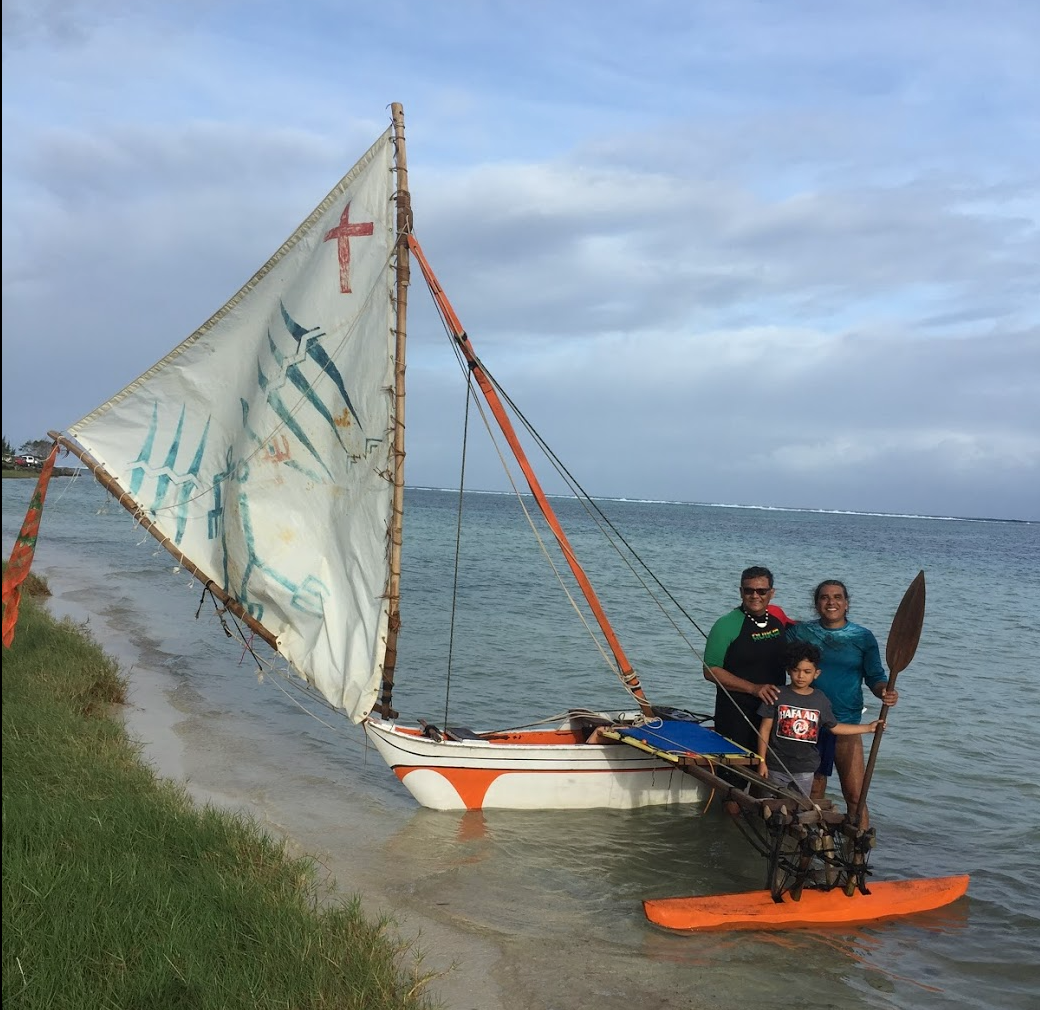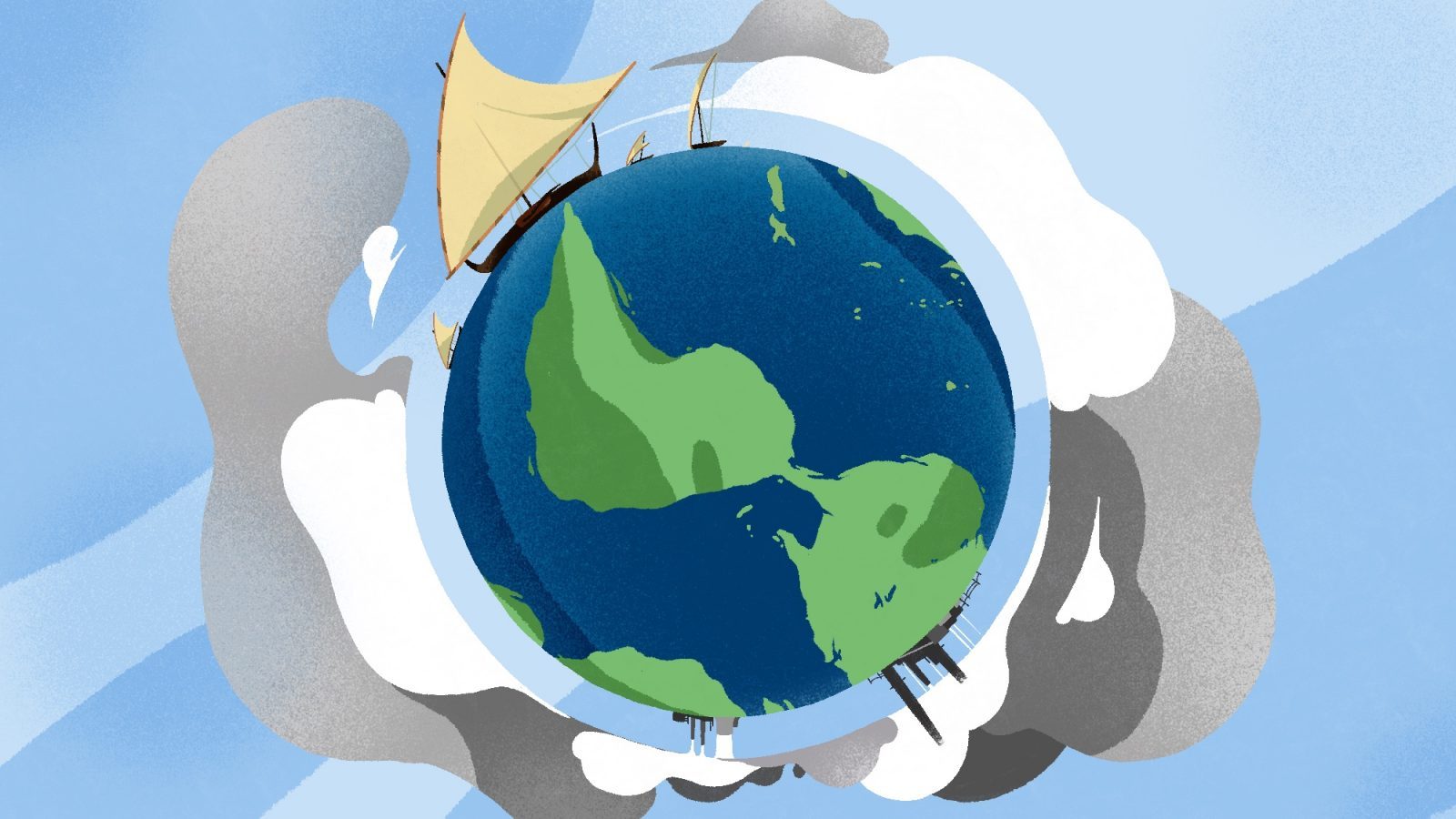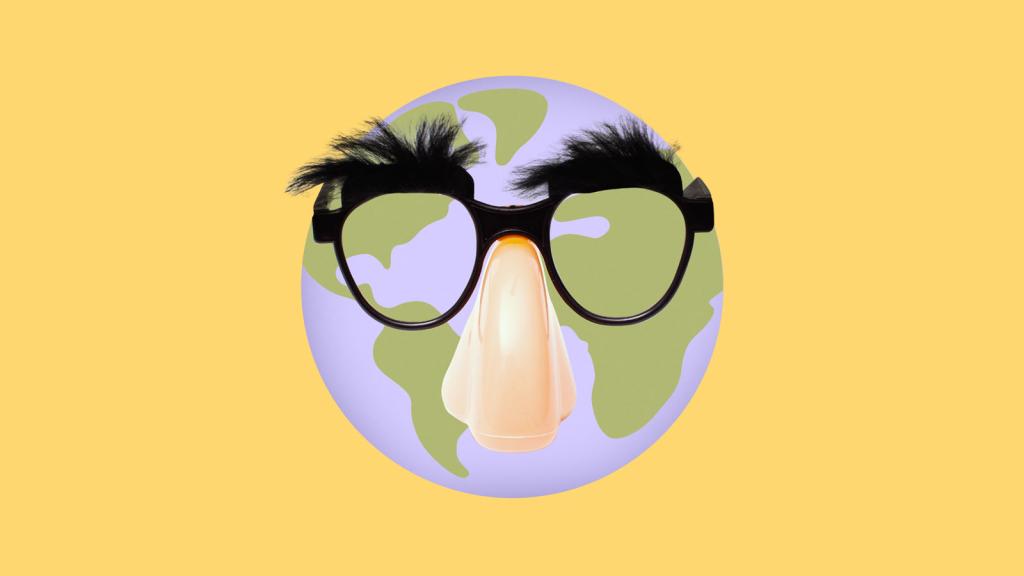Moñeka De Oro grew up hearing stories of her ancestors navigating the Pacific Ocean, hopping from island to island using only the stars, the currents, and the wind to guide them. She was 31 the first time she embarked on an inter-island voyage aboard a vaka motus, a traditional double-hull sailing canoe. Under luminous arrays of stars, she marveled at turtles and dolphins covered with bioluminescence riding the same waves propelling her vessel from Rota to Guam. “It was such a beautiful experience,” says De Oro, who is Chamorro, the native people of the Mariana Islands. “It just very much felt like the ancestors were with you.”
Pacific Islanders have in the centuries since colonization lived largely insular lives, separated from the rest of the world by a vast ocean. That has made them particularly attune to the land and sea, mindful of their impact and resilient to the storms that climate change is making increasingly violent and frequent. For generations, De Oro’s family has composted and recycled, fished responsibly, and used just enough energy to power their home. Although colonization has erased some Chamorro ancestral ways and wisdom, living sustainably is not at all unusual among folks there. As such, revitalizing Indigenous seafaring provides another way of decolonizing, decarbonizing, and reclaiming their culture.
And yet the 10 million or so people who call the islands of the Pacific home are paying the greatest cost for the failure of others to lead similar lives. Pacific Islanders have always been the most vulnerable victims of climate change as they grapple with intensifying storms, coastal erosion, and other crises that threaten not only their traditions, but their very existence. In Kiribati, many residents have become climate refugees fleeing sinking homes. In the Marshall Islands, a concrete dome holding some 3.1 million cubic feet of nuclear waste created for American atomic bomb tests is at risk of collapsing from rising seas. In parts of Hawaii, beach shorelines are rapidly receding. Such things are the norm throughout the region.
This existential crisis is compounded by decades of environmental racism that followed colonization and militarization by the United States, Spain, Japan, and others. Military bases dot the islands, spewing pollution, scarring the landscape with firing ranges, and displacing culturally sacred sites.
All of this has placed Pacific Islanders among the most frontline of frontline communities, yet their struggles and efforts remain largely overlooked by most of the world. Much like Native Americans and other Indigenous peoples, they offer centuries of experience preserving resources and living in harmony with the earth. As climate change accelerates, they’re combining this knowledge with Western science to fight the crisis. And they are speaking out with increasing urgency about a problem they had little role in creating. In doing so they are centering the voices and experiences of communities not often heard by a historically white movement.

“Pacific island nations are feeling the brunt of the impacts, even though we contribute the least amount of carbon dioxide and don’t consume a lot of fossil fuels,” says De Oro, a coordinator with the Micronesia Climate Change Alliance. “The fact that we are the most vulnerable and that some people are at risk of losing their entire homelands is a humanitarian crisis — and a crisis of morality.”
Cascading disasters
The region known as Oceania includes roughly 30,000 islands scattered across the Pacific. These remote islands range from tiny atolls just a few feet above sea level to majestic volcanic mountains and expansive archipelagos like the Federated States of Micronesia and the Marshall Islands. Some are uninhabited, while others are home to dozens of distinct peoples and cultures.
For many in the U.S. and elsewhere, climate change remains an abstract, far-off concept. They accept that it exists, but it does not yet impact their lives in any significant way. Pacific Islanders experience both the causes and effects of this unfolding crisis daily.
Rising sea levels, ocean acidification, and severe storms are forcing islanders to leave, creating a growing diaspora. Intensifying storms threaten livelihoods and traditional navigational systems. The acidifying ocean is decimating fish stocks and killing coral reefs. Extreme heat has brought wildfires to the Northern Marianas. Officials in low-lying nations like Kiribati and Tuvalu, which climate scientists predict could be uninhabitable within 100 years, are considering the very real possibility that thousands of residents may be forced to relocate.
Many can’t imagine abandoning ancestral lands, something 31-year-old Arlynne Chugen has contemplated since Typhoon Sudal flattened much of Yap in 2004. Even now she vividly recalls her mother waking the family at midnight to seek shelter inland. Huddled inside a store, clutching the sweater and CD player she grabbed before fleeing, Chugen watched the storm surge fill the area with water and debris. She’ll never forget the numbness and denial she felt upon discovering the wreckage of their home. The situation has only grown more dire as storms like Sudal became more common across Oceania. “The idea of having to move our lives somewhere else and that we would never come back here is something I can’t imagine,” Chugen says.
A 2020 report by the National Oceanic and Atmospheric Administration found that Guam will continue to face hotter temperatures, reef loss, stronger typhoons, and threatened freshwater supplies. Another report warns that portions of Saipan will be partially submerged by 2050. Although the studies are specific to the two U.S. territories, Pacific Islanders everywhere realize they face similar threats. “We all know that climate change is an existential threat to our community and ways of life,” De Oro says.
Beyond that frightening reality, deep colonial histories haunt the islands with legacies of environmental degradation, land loss, and cultural erasure. To many locals, the biggest offender is the U.S. military and its expanding presence on land and water taken from them for training, target practice, and housing troops.
The U.S. began occupying vast swaths of the Pacific during World War II. It maintains a military presence on dozens of islands, including Hawaii, Wake Island, and American Samoa, and hopes to expand its footprint with new facilities on Palau and a Marine base for an additional 5,000 troops on Guam. This infrastructure belches greenhouse gases into the atmosphere and leeches pollution into the ground and water. Its construction desecrated sacred land, destroyed ancient cultural artifacts, and impacted thousands of species.
Innovative Indigenous solutions
As climate change intensifies, communities across Oceania are combining Indigenous practices with the latest science to mitigate the impacts and adapt to the changes.
In Papua New Guinea, local residents use coconut oil as a cheaper, more sustainable alternative to diesel. Seafaring vessels throughout Micronesia and Melanesia favor solar panels and batteries instead of internal combustion. On islands like Tonga and Vanuatu, researchers work with locals to restore and conserve mangrove forests threatened by extreme weather and pollution because they protect communities against storm surges and sequester carbon.
Some islands are looking beyond mitigation to adaptation. In Tuvalu, for example, residents who refuse to leave are moving to higher ground or elevating their homes above rising tides.
Living on the frontlines of this global crisis also has made Pacific Islanders some of the most passionate voices demanding action. Marshall Islands President Hilda Heine relentlessly calls on world leaders to slash emissions. Poets like Terisa Siagatonu, Kathy Jetñil-Kijiner, and Craig Perez (who was recently honored on the Grist 50 list of emerging climate leaders) tell eloquent stories about the lived experiences of Pacific Islanders, amplifying their voices and inspiring Indigenous people and activists worldwide to do the same.
No less important is the ongoing effort to demilitarize the islands. In his book The Properties of Perpetual Light, Chamorro human rights lawyer Julian Aguon calls defending ecosystems like Guam’s forest floor an act of resistance against such occupation. Yo’åmte, or healers, rely upon such places for medicinal plants central to traditional healing practices. If the wider world understood that these plants treat “everything from anxiety to arthritis,” perhaps the land might be protected and preserved.
“But,” Aguon wrote, “no military on earth is sensitive enough to perceive something as soft as the whisper of another worldview,” which is why the demilitarization movement is so important to Pacific Islanders. Their protests, which range from physically defending areas slated for development to testifying before Congress and the United Nations, receive far less attention than demonstrations against pipelines and fracking sites but are no less vital in the push for environmental justice.
In that vein, Pacific Islander researchers are conducting groundbreaking work to address legacy military pollution and rising sea levels across Oceania. Fijian microbiologist Awei Bainivalu’s bioremediation research is exploring how bacteria found in petroleum could be used to convert oil leaking from World War II–era shipwrecks into a less toxic compound that won’t harm marine ecosystems. Such a breakthrough could create tools for tackling oil spills and other environmental catastrophes worldwide.
All of this is interconnected with the push to reclaim traditional customs, particularly seafaring. De Oro’s father, Art, leads 500 Sails, a nonprofit based in Saipan that promotes traditional canoe culture in the Marianas by revitalizing sakmans — the wayfinding proa made by the Chamorro people until the Spanish colonial government barred them from the sea in the late 1700s. The organization, founded by Chamorro elders Peter Perez and his wife Emma in 2017, hopes to enlist local residents in building 500 sakmans that combine designs based on written records and illustrations by Chamorro ancestors with modern materials like fiberglass and foam.
Meanwhile, the nonprofit Okeanos Foundation uses six vaka to ferry folks throughout the Federated States of Micronesia. More Chamorro people, thanks to master navigator Rob Limtiaco, are rediscovering ancestral navigational practices. Reclaiming this knowledge instead of relying on fossil fuels is a direct resistance to the climate crisis, De Oro says, and “a beautiful way to decolonize and decarbonize our livelihoods and just be in better and right relations with each other and our natural environment.”
De Oro believes it’s just a matter of time until the world realizes what it can learn from the ways Pacific Islanders have for millenia sustained their livelihoods and environments. “When I think of voices who have been discussing and wanting to bring attention to climate change, Pacific leaders have been champions of this issue,” she says. “There’s momentum going.
“It gives me a big sense of hope.”




